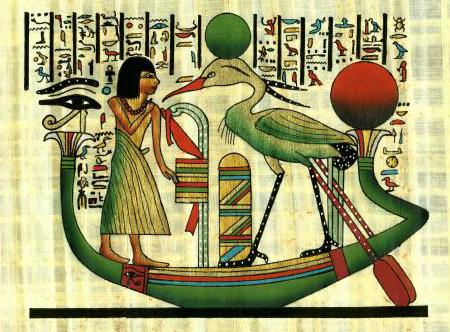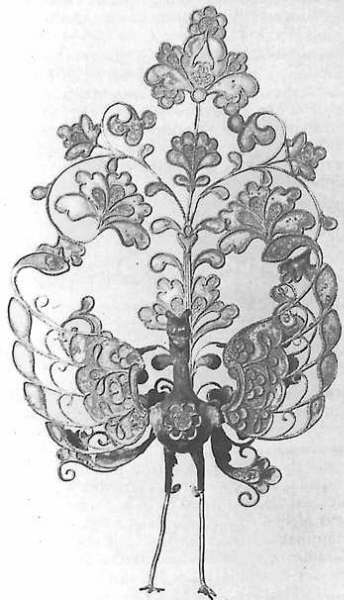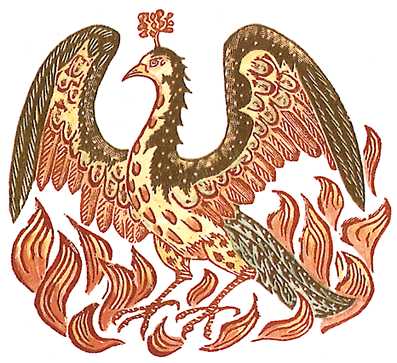| PHOENIX In ancient Egyptian mythology and in myths derived from it, the Phoenix is a female mythical sacred firebird. Said to live for 500 or 1461 years (depending on the source), the phoenix is a male bird with beautiful gold and red plumage. At the end of its life-cycle the phoenix builds itself a nest of cinnamon twigs that it then ignites; both nest and bird burn fiercely and are reduced to ashes, from which a new, young phoenix arises. The new phoenix embalms the ashes of the old phoenix in an egg made of myrrh and deposits it in Heliopolis ("the city of the sun" in Greek), located in Egypt. The bird was also said to regenerate when hurt or wounded by a foe, thus being almost immortal and invincible - a symbol of fire and divinity. 
Although descriptions (and life-span) vary, the phoenix (Bennu bird) became popular in early Christian art, literature and Christian symbolism, as a symbol of Christ, and further, represented the resurrection, immortality, and the life-after-death of Jesus Christ. Originally, the phoenix was identified by the Egyptians as a stork or heron-like bird called a bennu, known from the Book of the Dead and other Egyptian texts as one of the sacred symbols of worship at Heliopolis, closely associated with the rising sun and the Egyptian sun-god Ra. 
The Greeks adapted the word bennu (and also took over its further Egyptian meaning of date palm tree), and identified it with their own word phoenix, meaning the colour purple-red or crimson (cf Phoenicia). They and the Romans subsequently pictured the bird more like a peacock or an eagle. According to the Greeks the phoenix lived in Arabia next to a well. At dawn, it bathed in the water of the well, and the Greek sun-god Apollo stopped his chariot (the sun) in order to listen to its song. One inspiration that has been suggested for the Egyptian phoenix is a specific bird species of East Africa. This bird nests on salt flats that are too hot for its eggs or chicks to survive; it builds a mound several inches tall and large enough to support its egg, which it lays in that marginally cooler location. The convection currents around these mounds resembles the turbulence of a flame. In Russian folklore, the phoenix appears as the Firebird or firebird, subject of the famous 1910 ballet score by Stravinsky. The phoenix featured in the flags of Alexander Ypsilantis and of many other captains during the Greek Revolution, symbolizing Greece's rebirth, and was chosen by John Capodistria as the first Coat of Arms of the Greek State (1828-1832). In addition, the first modern Greek currency bore the name of phoenix. Despite being replaced by a royal Coat of Arms, it remained a popular symbol, and was used again in the 1930s by the Second Hellenic Republic. However, its use by the military junta of 1967-1974 made it extremely unpopular, and it has almost disappeared from use after 1974, with the notable exception of the Order of the Phoenix. The phoenix appears also on the city flags and seals of both Atlanta (torched in the US Civil War) and San Francisco (destroyed by earthquake and fire in 1906) to symbolize their respective rebirths from the ashes. Additional Information - Wikipedia
Chinese Mythology 
T'ang dynasty gold phoenix hair ornament lent its wearer the protection
and majesty of the bird, one of the Four Sacred Creatures.
The Feng-huang or Fung; the "vermilion bird," the "substance of the flame." The Feng has the head and comb of a pheasant and the tail of a peacock. It personifies the primordial force of the heavens. I t is one of the Four Spiritually Endowed, or Sacred, Creatures and like the dragon and ky-lin, with which it is always associated, it is both yin and yang. When it is the male feng it becomes yang, solar, the fire bird; but as the huang it is feminine, yin, and lunar. When portrayed with the dragon as a symbol of the Emperor, the phoenix becomes entirely feminine as the Empress, and together they represent both aspects of imperial power. Like the dragon and ky-lin, the phoenix is made up of various elements, typifying the entire cosmos; it has the head of a cock (the sun), the back of a swallow as the crescent moon, its wings are the wind, its tail represents trees and flowers, and its feet are the earth; it has five colors symbolizing the five virtues; "Its color delights the eye, its comb expresses righteousness, its tongue utters sincerity, its voice chants melody, its ear enjoys music, its heart conforms to regulations, its breast contains the treasures of literature, and its spurs are powerful against transgressors" (from an ancient ritual) The Feminine aspect (huang), denotes beauty, delicacy of feeling, and peace. It is also a bridal symbol signifying "inseparable fellowship." This is not only for the married couple but for the complete yin-yang mutual interdependence in the universe in terms of duality.
Japanese Mythology The sun; rectitude; fidelity; justice; obedience
Roman Mythology The rebirth and perpetual existence of the Roman Empire; imperial apotheosis.
Hindu Mythology 
In Indian mythology we find the Garuda. He is depicted having the beak, wings, talons, and tail of an eagle, and the body and legs of a man (sometimes having four arms). Garuda was semi-divine, as he was the mount of Vishnu. Garuda personifies the sun, as well as being the enemy of snakes.
Christian Mythology 
Resurrection; Christ consumed in the fires of Passion and rising again on the third day; triumph over death; faith; constancy; Christ's divine nature (as the Pelican was of his human nature). In early Christian tradition the phoenix was adopted as being resurrection and immortality. Through Christian eyes, we are taught to believe in the resurrection, as Christ himself exhibited the character of the phoenix: "I have the power to lay down my life and to take it up again." Using Christ's life as an example, one can live a similar learning life of rejuvenation. The phoenix makes a coffin and fills it with fine smelling spices, then dies where the stink of corruption is (effaced) by (agreeable) smells. Man may make a coffin of faith, faith being Christ, who sheathes and protects you in days of trouble. Your good spices are your virtues-chastity, compassion, and justice, being odors of noble deeds, sweet in life (as Christian doctrine dictates). Depart from life with the clothing of this faith, and as St. Paul states, "I have fought the good fight, I have finished the course, I have kept the faith, the crown of justice is restored to me." Thus, as with all other symbols, there is a cycle, a returning to something, as in many things of life. A symbol occurs because of its reflective association (the return) with the one viewing the symbol. It is lived through the interpretation of the viewer. 
Information Found at Crystalinks |  Free Forum Hosting
Free Forum Hosting